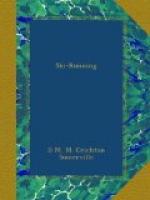2. Throughout the Test candidates must carry rucksacks, which should weigh about six lbs. for men, and three lbs. for ladies. The ski must not be removed during the test, except to clean or repair them.
3. The Judges should, if possible, appoint two time-keepers. During the descent not more than six candidates must be judged in one batch.
4. Not more than three attempts at Part (b), and not more than three attempts at Part (c) are allowed on the same day.
5. The attention of the Judges is directed to the General Instructions. The gradient on which Third Class candidates are expected to do their turns is gentle, as the intention is to secure that candidates should master the proper methods, so as to be able later to make real use of the turns on steep slopes. Judges are therefore urged to insist that the stemming turns and Telemarks are done correctly and in good style. Each turn should be short, well defined, and not a mere change of direction.
QUALIFYING TEST FOR THE SECOND CLASS (CROSS COUNTRY).
No Candidate may enter for Parts (a), (b) and (c) of the Second Class Test until he has passed the Qualifying Test, and no Candidate may enter for the Qualifying Test until he has passed the Third Class Test.
The Qualifying Test consists of three parts, which may be passed on different days and before different judges, but which must all be passed in the same season.
Part (a).—Four continuous Lifted Stemming turns on a slope of hard snow at an angle of 25-30 degrees.
Part (b).—Four continuous Telemark turns on a slope of soft snow at an angle of 25-30 degrees.
Part (c).—Christiania swings to a standstill (right and left) from a direct descent at a fair speed.
INSTRUCTIONS TO JUDGES.
1. Not more than three attempts at any one part should be allowed on the same day.
2. The Christianias should be done on the level or on a gentle slope after a descent from a steep slope, as a stop Christiania is more difficult on the level than on the slope.
3. The Judges must require a considerably higher standard of steadiness and certainty than in the Third Class Test. The object of the Third Class Test is to ensure that candidates learn the correct methods of making the turns. The object of the Second Class Test is to ensure that candidates can make practical use of these turns on moderately steep slopes.
THE SECOND CLASS TEST (CROSS COUNTRY).
The Second Class Test consists of three parts, which must all be passed in the same season, and should, if possible, be judged by the same Judges.
Part (a).—A descent of not less than 2,500 feet, mainly on soft snow. The course selected should provide opportunities for straight running on reasonably steep slopes.




